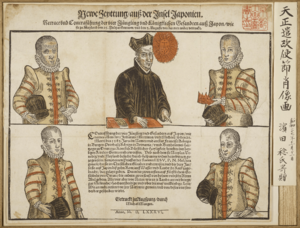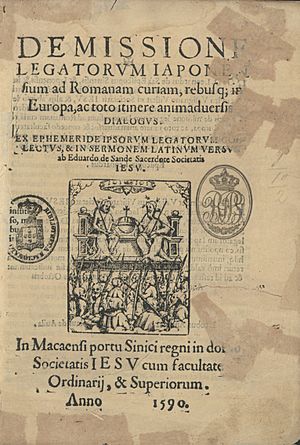Tenshō embassy facts for kids

The Tenshō embassy (Japanese: 天正の使節) was a special trip made by a group of Japanese Christians to Europe in 1582. It was named after the Tenshō Era in Japan when the trip happened. This journey was organized by a Japanese Christian leader named Ōtomo Sōrin. The main goal was to meet the Pope and important kings in Europe.
The embassy was led by Mancio Itō (伊東 マンショ, 1570–1612). He was a Japanese nobleman and the first official Japanese person to be sent on such a mission to Europe.
Contents
Why Was the Embassy Sent?
The idea for this important trip came from a Jesuit priest named Alessandro Valignano. The trip was supported by three powerful Japanese Christian lords, known as daimyōs:
- Ōmura Sumitada (1533–1587)
- Ōtomo Sōrin (1530–1587)
- Arima Harunobu (1567–1612)
Mancio Itō was chosen to speak for the group sent by Ōtomo Sōrin. Ōtomo Sōrin was a daimyō from the Bungo Province in Kyūshū. He was also a close relative of Mancio's father.
The Journey to Europe
On February 20, 1582, Mancio Itō left Nagasaki. He traveled with three other young noblemen:
- Miguel Chijiwa (千々石 ミゲル)
- Julião Nakaura (中浦 ジュリアン)
- Martinho Hara (原 マルチノ)
They also had two servants, their teacher and interpreter Diogo de Mesquita. Their mentor, Valignano, traveled with them only as far as Goa in Portuguese India. He had new duties there.
On their way to Lisbon, Portugal, they visited many places. These included Macau, Kochi, Dubai, Madagascar, and Goa. They arrived in Lisbon in August 1584.
Meeting Important People
From Lisbon, the ambassadors continued their journey. Their main goals were to visit Madrid, Spain, and Rome, Italy. In Spain, they met Philip II, who was the King of Spain and Portugal. They also visited places like Talavera de la Reina, Toledo, El Escorial monastery, and Alcalá University.
When they arrived in Rome, Mancio Itō received a special honor. He became an honorary citizen and was given the title Cavaliere di Speron d'oro ("Knight of the Golden Spur"). This meant he was now part of the European nobility.
During their long stay in Europe, they met many important leaders:
- King Philip II of Spain
- Francesco I de' Medici, the Grand Duke of Tuscany
- Pope Gregory XIII
- His successor, Pope Sixtus V
The Return Home
The ambassadors finally arrived back in Japan on July 21, 1590. Their journey had lasted eight years! During their trip, they were told to write down everything they saw and learned. These notes were used to create a book called De Missione Legatorum Iaponensium ad Romanam Curiam. This book, published in 1590, was about "The Mission of the Japanese Legates to the Roman Curia" (the Pope's government).
The four young men later became the first Japanese Jesuit priests. This was a special religious role.
Sadly, their lives after the embassy were not always easy:
- Mancio Itō passed away in Nagasaki on November 13, 1612.
- Martinho Hara was forced to leave Japan in 1614 by the Tokugawa shogunate (the Japanese government at the time). He worked in Macau and died there on October 23, 1629.
- Miguel Chijiwa left the Jesuit order before 1601. He died in Nagasaki on January 23, 1633. For a long time, people thought he had stopped being a Christian. But in 2017, rosary beads were found in his grave, which made people wonder if he had stayed Christian after all.
- Julião Nakaura was captured by the Tokugawa shogunate. He died as a martyr (someone who dies for their beliefs) from torture in Nagasaki on November 21, 1633. He was later beatified on November 24, 2008. This is a step towards becoming a saint in the Catholic Church.
A Timeline of Their Trip
1583
- February: Four Japanese noblemen – Mancio Itō, Miguel Chijiwa, Julião Nakaura, and Martinho Hara – leave Nagasaki. They are with Alessandro Valignano, Father Nuno Rodrigues, translator Diogo de Mesquita, and a servant.
- March 9: They arrive in Macau. A Chinese servant joins their group.
- They travel from Malacca to Cochin and Goa.
- September 12: Valignano writes instructions in Goa. Father Nuno Rodrigues takes charge of the group.
1584
- August 10: They reach Lisbon, Portugal.
- September: They visit Évora.
- October 1: In Toledo, they are welcomed by Archbishop Gaspar de Quiroga.
- October 20: They arrive in Madrid. Hara gets sick.
- November 14: They are received by King Philip II.
- November: They visit Empress Maria of Austria and El Escorial monastery. They even see the king's Indian rhinoceros!
- November 26: They are in Alcala de Henares.
- Christmas: They spend Christmas in Murcia.
1585
- January: They visit Alicante.
- March 1: They arrive in Livorno, Italy.
- March 2: They visit Pisa.
- March 7: They are in Florence.
- March 22: They arrive in Rome. They are welcomed by Father General Claudio Acquaviva at the Church of the Gesù. Nakaura is sick with a fever.
- March 23: They travel through crowds from Villa Giulia to Castle of St. Angelo. Then they go to the Vatican to attend a special meeting with the Pope. They are hugged by Pope Gregory XIII. They eat in the Pope's rooms. They receive new clothes. They give the Pope two beautiful folding screens (which are now lost). These screens showed Azuchi, where Nobunaga's castle was.
- April 10: Pope Gregory XIII dies.
- May 1: Pope Sixtus V is crowned.
- May: Pope Sixtus knights them into the Order of the Golden Spur.
- June 3: They leave Rome.
- June: They visit Assisi and Loreto.
- June 25: They arrive in Chioggia by riverboat from Ferrara. They are escorted to Venice to great cheers.
- July 13: They visit Mantua.
- July: They visit Verona.
- July 25: They are in Milan.
- August 8: They visit Genoa.
- August 16: They are in Barcelona.
- September: They visit Santa Maria de Montserrat Abbey.
- They also visit Monzón and Zaragoza.
- They return through Alcalá de Henares, Madrid, Vila Viçosa, Évora, and Coimbra.
1586
- April 8: They leave Lisbon to return to Japan.
1587
- May 29: They reach Goa and meet Valignano again.
1590
- July 21: They finally arrive back in Japan.
See also
- Bernardo the Japanese, the first Japanese person to visit Europe, in 1553.
- Hasekura Tsunenaga, another Japanese embassy to Europe in 1615.
 In Spanish: Embajada Tenshō para niños
In Spanish: Embajada Tenshō para niños



